I've got an AVR ISP MK2 that I'm going to program an ATmega328P with using ISP. This is the schematic of the 2x5 pin ICSP connector:

First: Does this mean that I am supposed to connect #2 to +5V and #{4,6,8,10} to ground? Why does the programmer need another power supply when it already has USB?
Second: My plan is to cut the 10-lead flat cable up and solder the individual leads for my prototype. How can I know which lead corresponds to which pin?